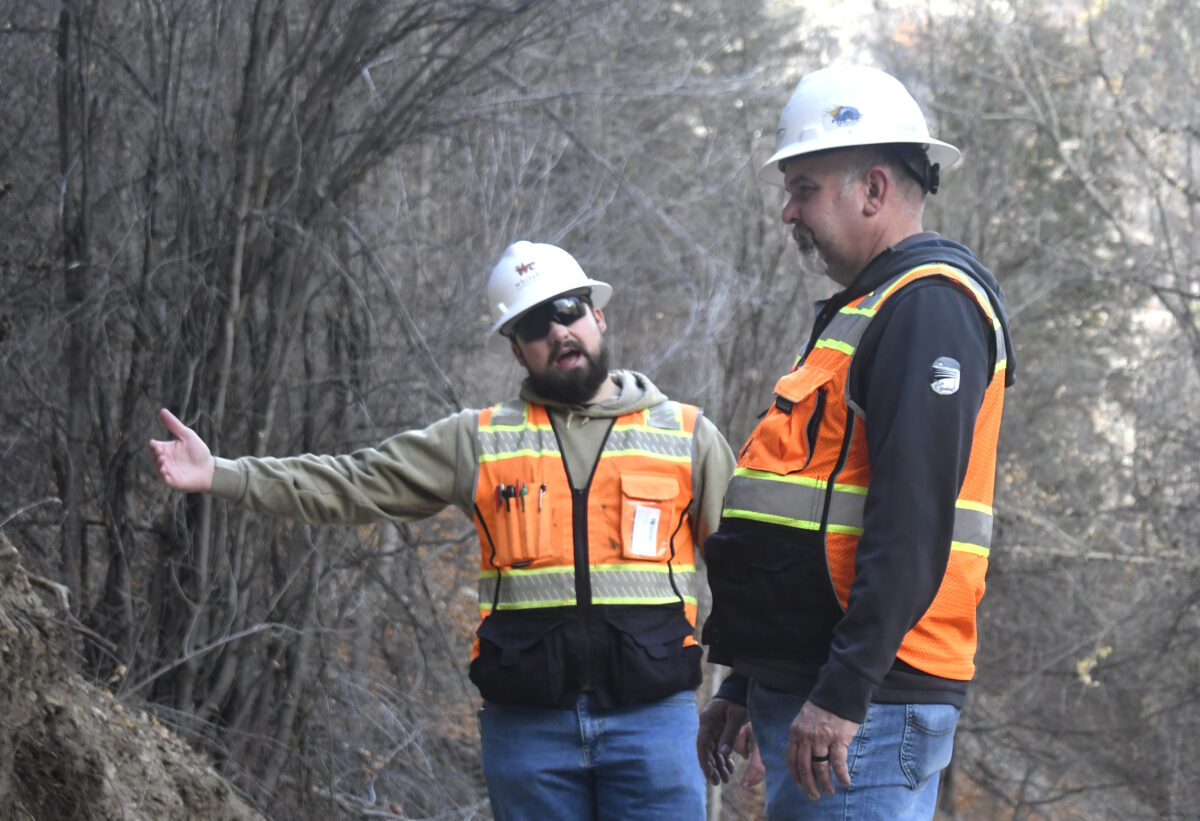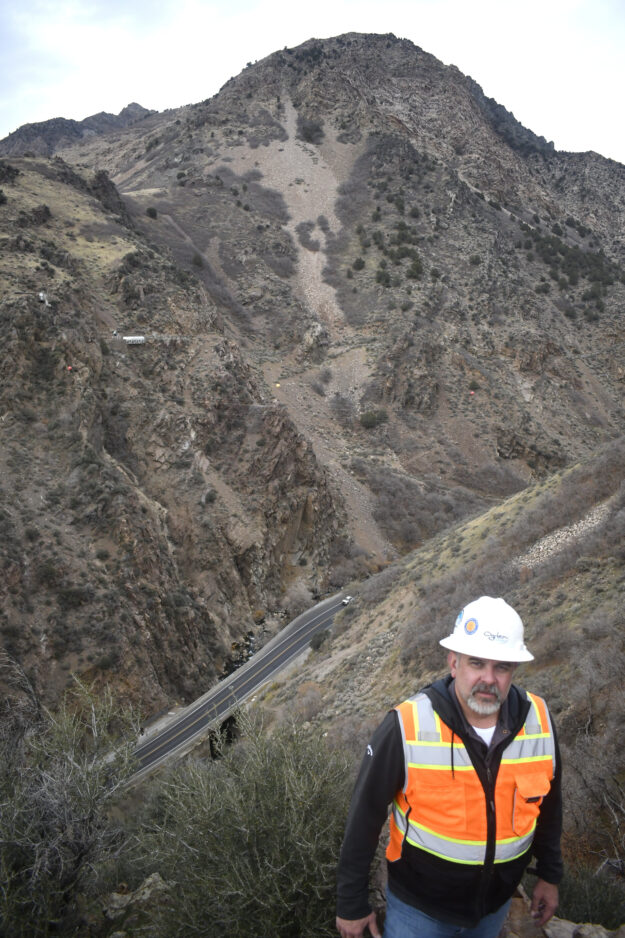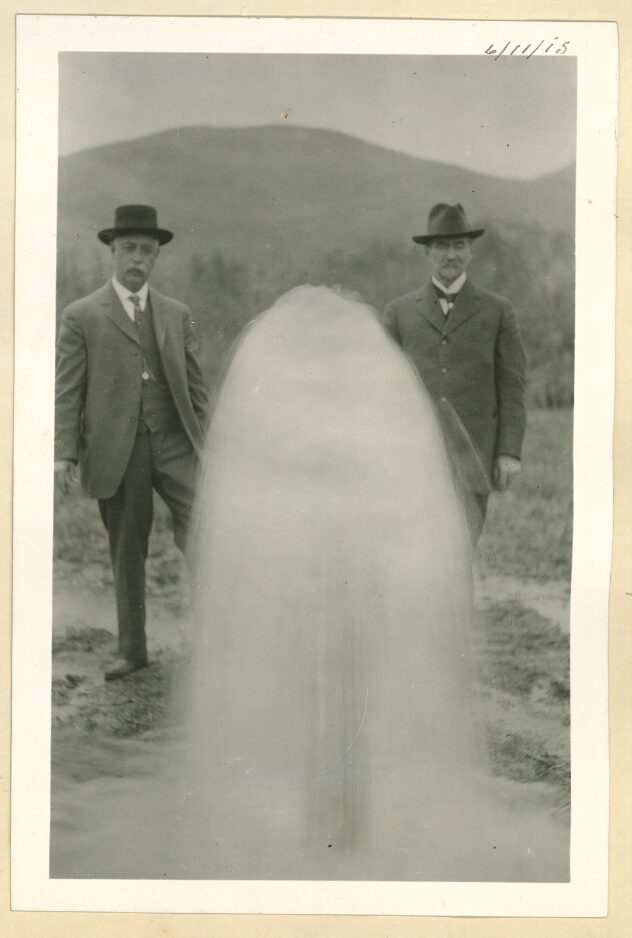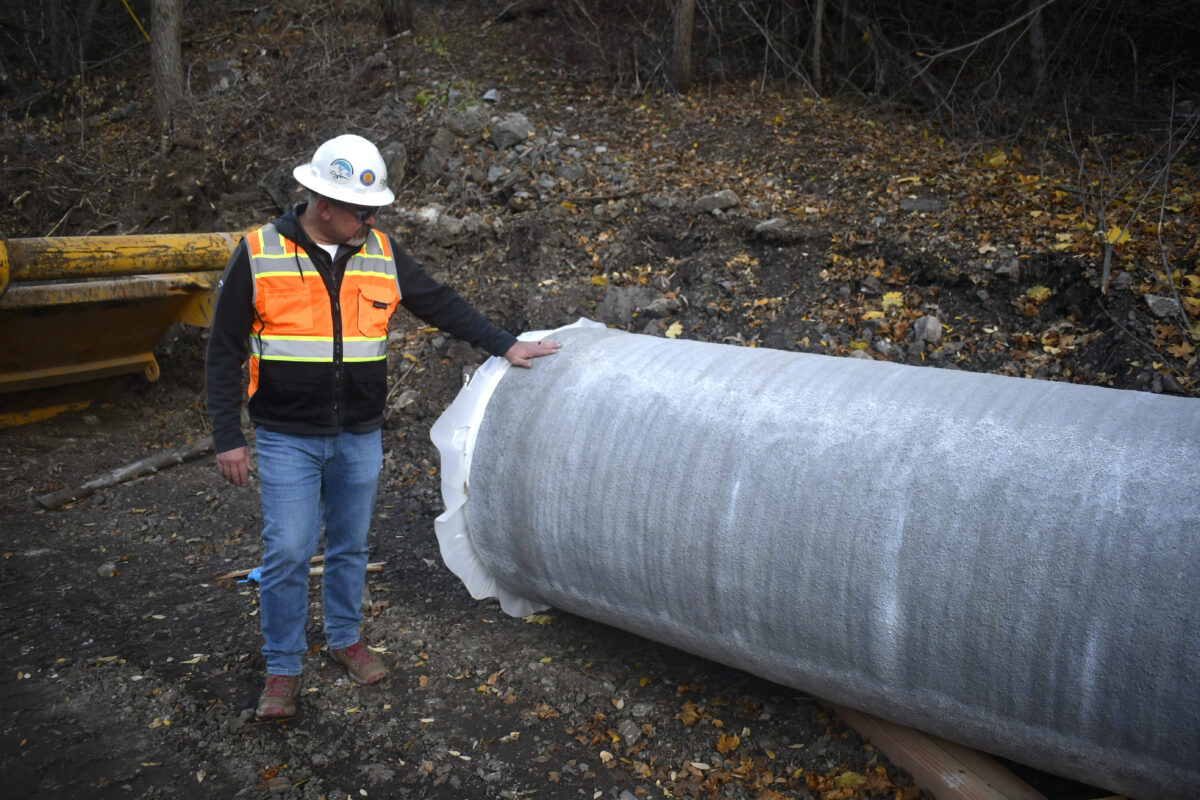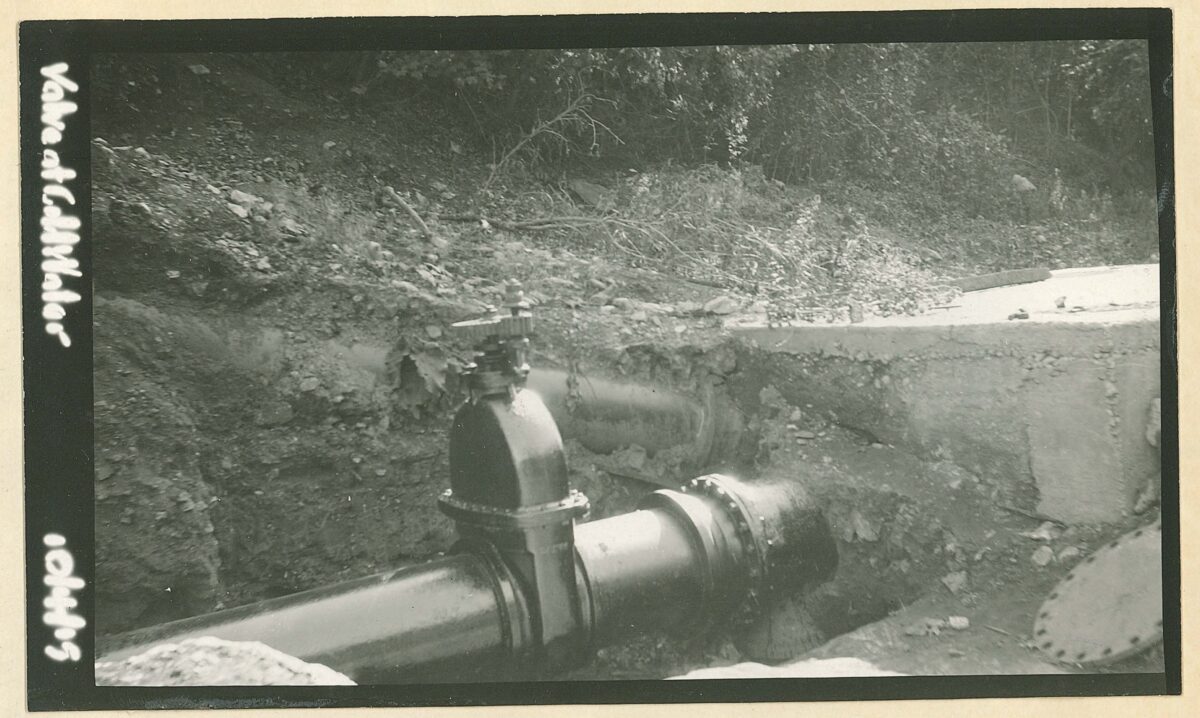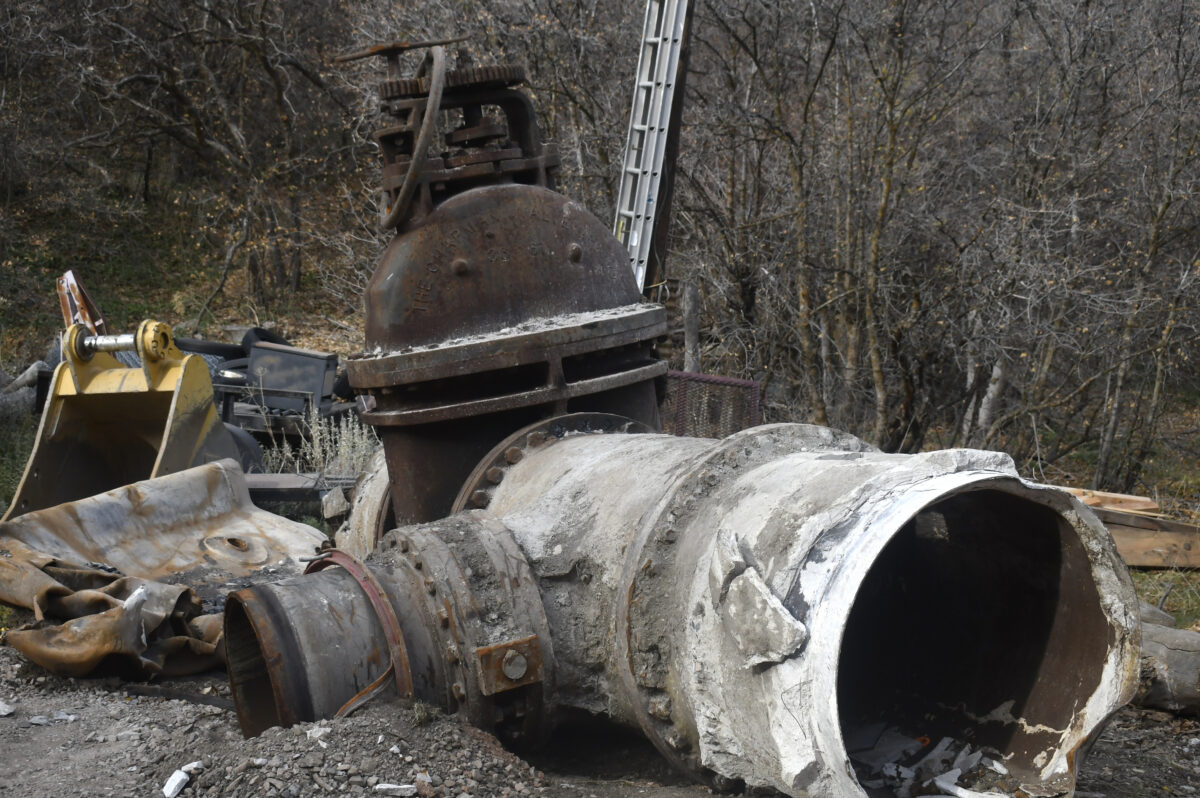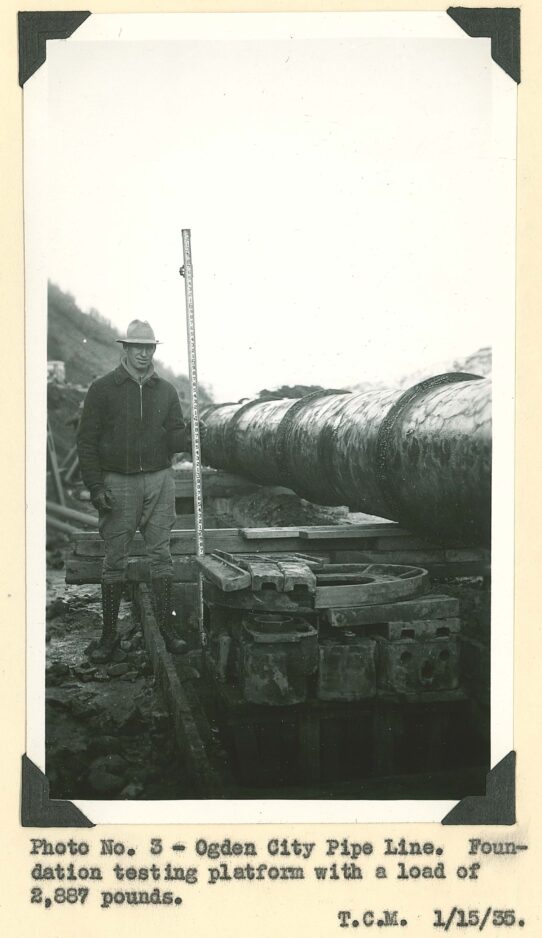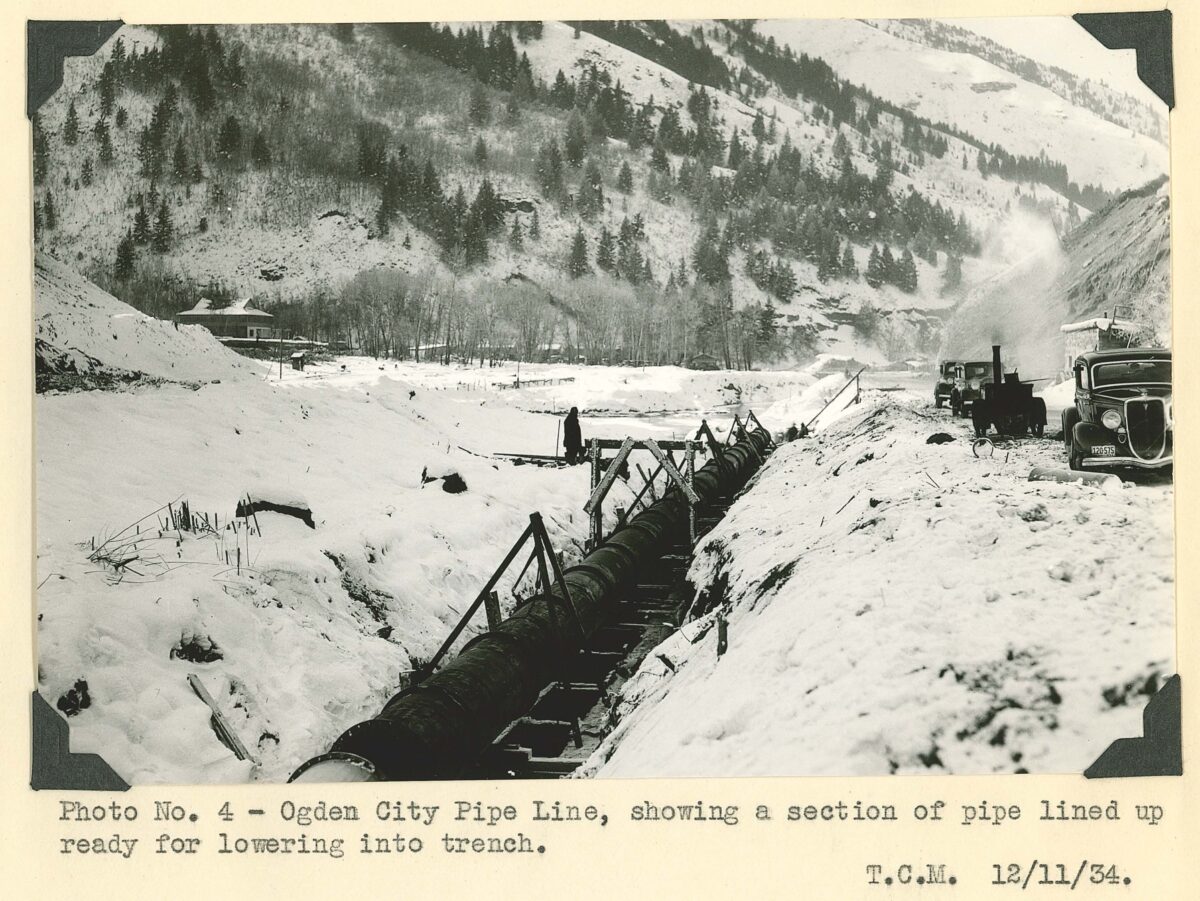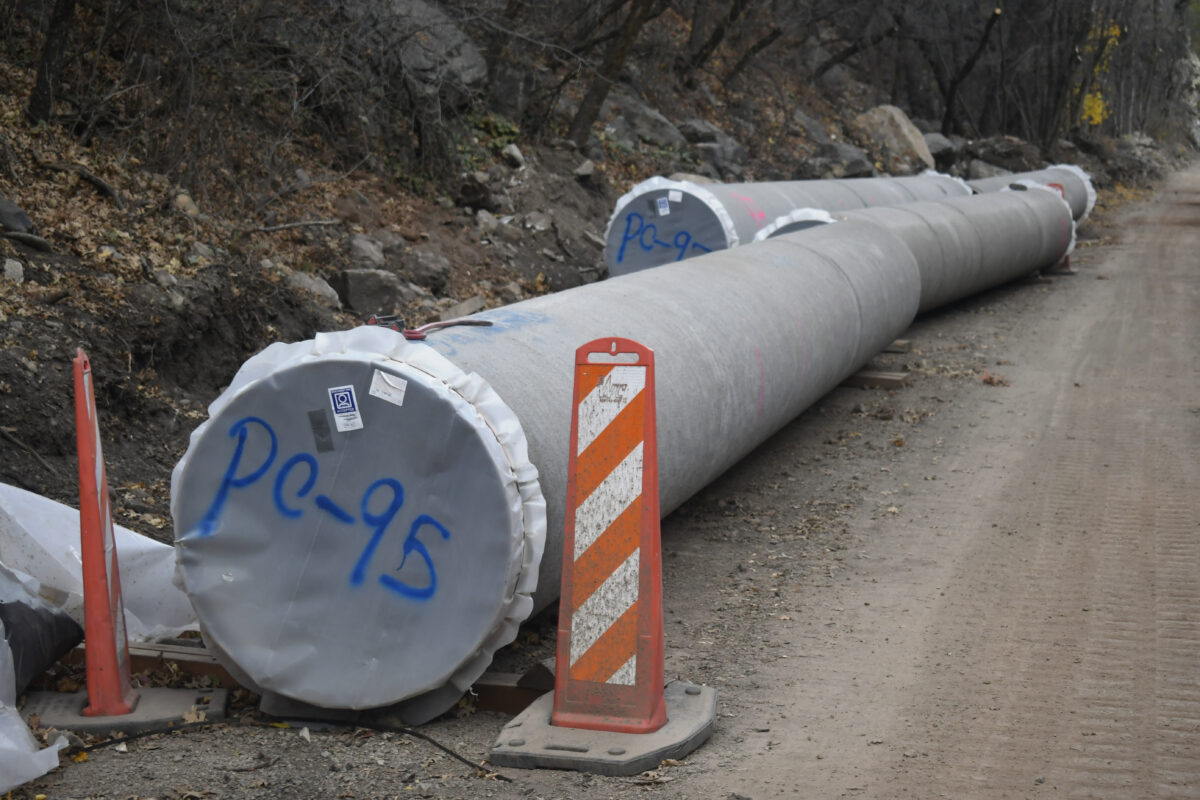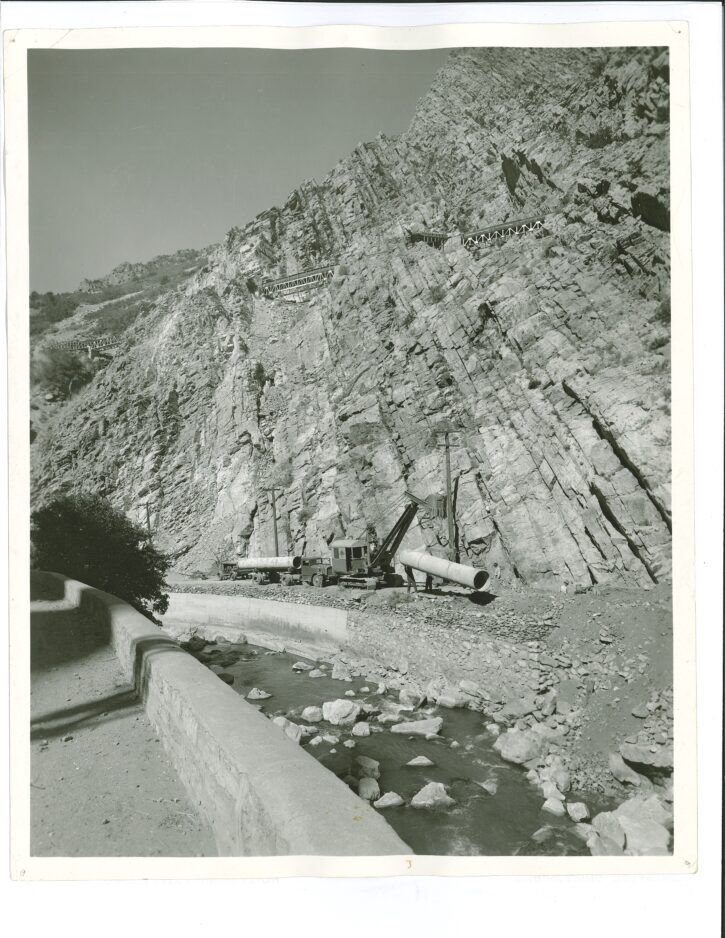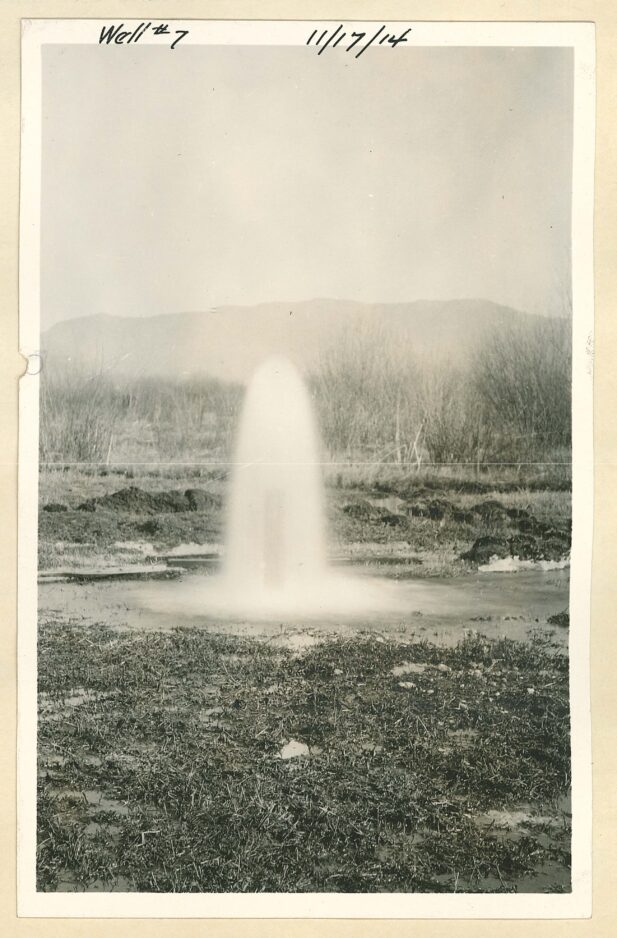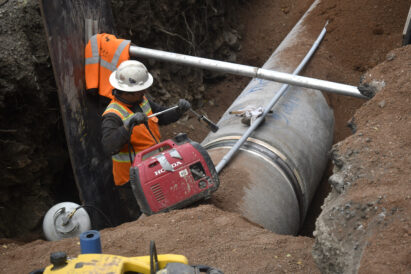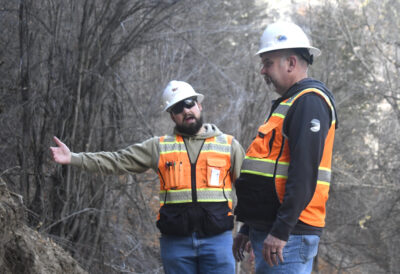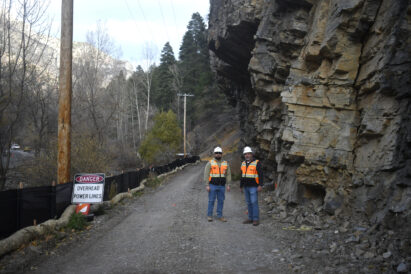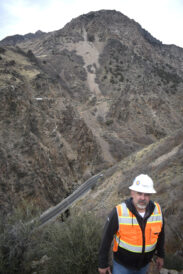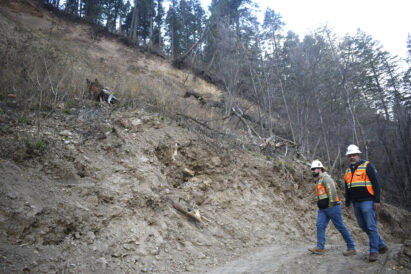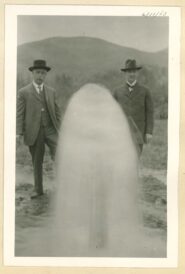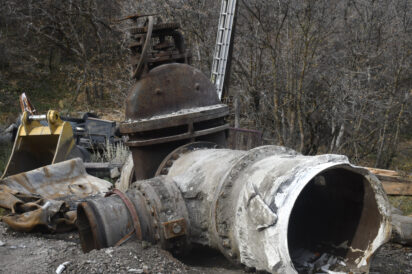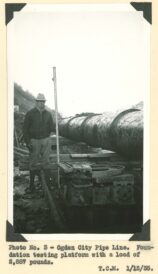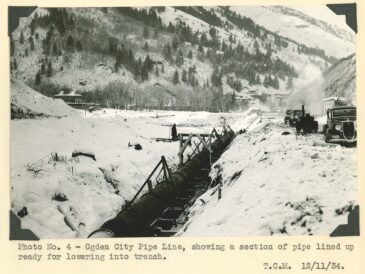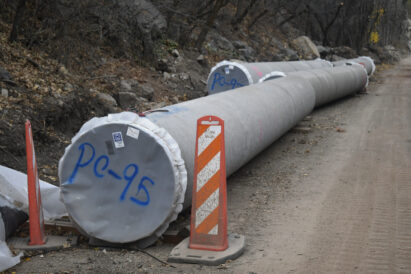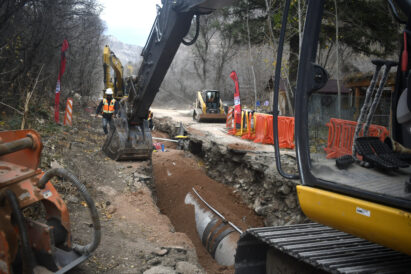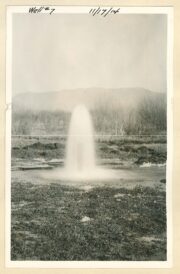Through the years: Water pipe replacement in Ogden Canyon ties past and future
- Justin Anderson, executive director of Ogden City Public Services, left, and Cord Skeen, project manager for Whitaker Construction, stand near a recently installed section of pipe as part of the Ogden City water pipeline replacement project in Ogden Canyon on Friday, Nov. 14, 2025.
- A worker from Whitaker Construction installs a section of pipe as part of the Ogden City water pipeline replacement project in Ogden Canyon on Friday, Nov. 14, 2025.
- Justin Anderson, executive director of Ogden City Public Services, right, and Cord Skeen, project manager for Whitaker Construction, examine a slide area that will need to be carefully removed as part of the Ogden City water pipeline replacement project in Ogden Canyon on Friday, Nov. 14, 2025.
- Justin Anderson, executive director of Ogden City Public Services, right, and Cord Skeen, project manager for Whitaker Construction, stand by a rock overhang that will need to be carefully navigated as part of the Ogden City water pipeline replacement project in Ogden Canyon on Friday, Nov. 14, 2025.
- Justin Anderson, executive director of Ogden City Public Services, stands on a hillside where pipe will need to be placed to carry water up to the city’s reservoir as part of the Ogden City water pipeline replacement project in Ogden Canyon on Friday, Nov. 14, 2025.
- Justin Anderson, executive director of Ogden City Public Services, right, and Cord Skeen, project manager for Whitaker Construction, examine a slide area that will need to be carefully removed as part of the Ogden City water pipeline replacement project in Ogden Canyon on Friday, Nov. 14, 2025.
- An artesian well in Ogden Valley is shown in a photo graph taken on June 11, 1915.
- Justin Anderson, executive director of Ogden City Public Services, looks at a section of pipe ready to be installed as part of the Ogden City water pipeline replacement project in Ogden Canyon on Friday, Nov. 14, 2025.
- An Ogden City water pipeline valve is shown in a photograph taken on Oct. 4, 1915.
- A valve from the old pipeline was removed as part of the Ogden City water pipeline replacement project in Ogden Canyon on Friday, Nov. 14, 2025.
- Workers work on putting in the Ogden City water pipeline in Ogden Canyon in a photo taken on Jan. 15, 1935.
- Workers from Whitaker Construction install a section of pipe as part of the Ogden City water pipeline replacement project in Ogden Canyon on Friday, Nov. 14, 2025.
- Workers work on putting in the Ogden City water pipeline in Ogden Canyon in a photo taken on Dec. 11, 1934.
- Pipe sits ready to be installed as part of the Ogden City water pipeline replacement project in Ogden Canyon on Friday, Nov. 14, 2025.
- Workers work on putting in the Ogden City water pipeline in Ogden Canyon in a photo taken on Oct. 12, 1937.
- Workers from Whitaker Construction install a section of pipe as part of the Ogden City water pipeline replacement project in Ogden Canyon on Friday, Nov. 14, 2025.
- An artesian well in Ogden Valley is shown in a photograph taken on Nov. 17, 1914.
Turn on a faucet … and water comes out.
It’s such a routine activity that the only time most of us think much about it is when something goes wrong.
But to make something that is now so commonplace happen in homes and businesses throughout Northern Utah required thousands of hours of labor in the past and thousands more in terms of maintenance and upkeep.
Few understand it as well as Justin Anderson, executive director of Ogden City Public Services, who has the job of making sure the city’s infrastructure is in place so water gets where it needs to be.
He’s worked on a variety of water-related projects over the years, but a big current focus is one that has been 90 years in the making.
The source of water
Much of Ogden City’s drinking water comes from an artesian well area east in Ogden Valley. That means the city needs to have a way to get that water through Ogden Canyon through pipelines.
“There is a pipe that takes water from our well field, which got moved when they built Pine View dam to where it is now on the north side of the middle inlet,” Anderson said in an interview earlier in November. “Water comes in from that, all the way down the roadway, down the face of the dam, to where our water treatment plant is. From there, we are able to add additional water to this and then we divide up into two pipes.”
This infrastructure was put in place in the canyon 90 years ago and has been the main conduit for water ever since.
“This pipe was installed in the 1930s and it took, I believe, about six years to install when they installed it,” Anderson said. “The 36-inch pipe and the 24-inch pipe going down the canyon provide two-thirds of the culinary water to Ogden City.”
The city replaced the 24-inch pipe in 2014, but the bigger pipe was going to provide a bigger challenge, which is why Anderson has been working on the project for 15 years.
The need for replacement
The original engineers deserve credit for putting a line in place that served the city’s needs for nearly a century — but eventually time was going to take its toll.
“Once a pipe hits 80 years to 90 years old, it it is due to fail,” Anderson said. “There’s been two tests on this pipe during my time at the city, with the first one being done in 2008. They both determined that there were leaks happening in this pipe with a large quantity of water leaking.”
The smaller pipe was leaking a lot more, Anderson explained, which was one reason it was replaced first. But losing water from the aging line was a concern the city couldn’t ignore.
“If you look at it from purely the water conservation aspect, this was water that we’re pulling up out of the ground with energy costs and then treating, only to lose it,” Anderson said. “If we can prevent that loss, we can reduce how much are drawing up. Through my experience at the city, all conservation is fantastic. It all adds up, so it’s just invaluable to fix these leaking pipes.”
The scope of the project
While the need is undeniable, replacing the old pipeline is not a task to be taken lightly.
“It’s just under eight miles of pipe that’s need to go from our well field to the 23rd Street reservoir,” Anderson said. “There are places that we change elevation gradually, but at the mouth of the canyon, we’ve got to get the water 800 feet up the side of the canyon to get it to the reservoir.”
He explained that the city is also very aware of the water needs during peak usage time in the spring and summer, so as much of the work as possible is being done from October through the end of April.
Anderson said the project, which began last January and is slated to be completed in 2028, is on schedule (perhaps slightly ahead of schedule thanks to the mild October and November weather) and on budget.
Challenges to be overcome
To execute the project, Ogden City hired Whitaker Construction, a company with a great reputation for getting things done effectively in difficult canyon terrain.
“This is a unique situation,” said Cord Skeen, project manager for Whitaker Construction. “We’ve been involved from the inception of design and we’ve been working with the engineer directly in some of the construction constraints that we foresee, helping dial in few things as far as connections and where things are going. It’s a unique opportunity.”
But even with a contractor that knows what its doing, there are some significant challenges including:
1. Working safely with canyon residents
Many people make the canyon their home, often with little or no knowledge that their properties were near a pipeline easement.
Skeen and Anderson explained that trying to keep the residents informed has been a key undertaking as they are working on getting the old pipe out and the new pipe in.
“All the services to the community members need — such as trash, propane, emergency services — those are all things that we’ve had to sit down and design out for community members,” Skeen said. “A project of this scale is difficult for people to grasp because they don’t see it every day. There’s a lot that goes into it that they’re not aware of. To have them involved in these community meetings, it’s been a cool process to inform them and give them a heads up of what’s coming, and work with them to make sure everything runs smoothly.”
2. Getting the materials in and out of the narrow canyon efficiently
Anyone who has made the trip up Ogden Canyon knows that there is limited access and tight turns to deal with. Skeen said Whitaker Construction works hard to make sure it has the equipment and materials where they need to be when they need them.
“Logistics is huge in this scenario,” he said. “We have to manage production rates, see how much footage we can get in today, so we can plan how much pipe to bring up the canyon. You have to plan those daily so that we don’t have any excess so the community members can get back in.”
3. Getting through a tight corridor with an overhanging rockface
A section of the old pipe being replaced is pinned on the south side of the river with power lines on one side of the easement and a rockface on the other. It’s a spot Skeen and his crew wants to complete quickly and before the spring thaw.
“There is a safety concern at every turn,” Skeen said. “You are working in tight corridors. We always have spotters in place, making sure we keep our guys and the community safe.”
4. Working through a stretch with a small landslide that is still unstable
A small landside covered the pipeline with more than 20 feet of dirt and debris, but the bigger concern is that the area is still unstable. Removing the slide could result in another slide, so the work in the area will be done carefully, including efforts to shore up the hillside where the slide came down.
Moving forward and end goals
Skeen said the project is currently going well.
“We have installed roughly 1,300 feet of pipe,” he said. “We started laying about the second or first or second week of October, so we’ve done that within a months time frame. Progress is going really well. We’re actually bringing a second crew in starting next week. We’ll have them kind of work working toward the middle point to help stay ahead of our production.”
Anderson said that the $100 million price tag for the project meant that a lot of work had to be done to ensure the funding was in place before work began.
But the objectives are something he takes pride in being a part of.
“We absolutely want this to be a legacy project,” Anderson said. “When we’re building this, we’ve thought through the material type, we’ve thought through the construction process, even all the way down to how we’re bedding the pipeline. The intent is that this is not just a pipeline that’s going to last 80 to 100 years. We want to see this pipeline last hundreds of years.”
For more information on the project, go to https://www.ogdencity.gov/268/Engineering.



